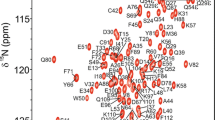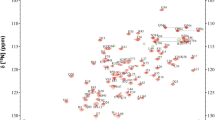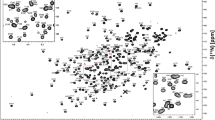Abstract
Trypanosoma cruzi is a human parasite that causes Chagas disease, an illness affecting millions of people and without an efficient treatment available. Sequencing the pathogen genome has revealed that near half of protein-coding genes correspond to hypothetical proteins of unknown function, increasing the possibilities for novel target discovery. Q4D059 is a putative essential hypothetical protein from T. cruzi and it is specific and conserved among the trypanosomatid genomes. Here, we report the sequential backbone and side chain resonance assignments and secondary structure analysis of Q4D059, as first step for protein structure determination, function elucidation and drug screening.


Similar content being viewed by others
References
Alsford S, Turner DJ, Obado SO, Sanchez-Flores A, Glover L, Berriman M, Hertz-Fowler C, Horn D (2011) High-throughput phenotyping using parallel sequencing of RNA interference targets in the African trypanosome. Genome Res 21(6):915–924
Berriman M et al (2005) The genome of the African trypanosome Trypanosoma brucei. Science 309:416–422
Cavanagh J, Fairbrother WJ, Palmer AG, Skelton NJ (1996) Protein NMR spectroscopy, principles and practice. Academic Press Inc, San Diego
El-Sayed NM et al (2005) The genome sequence of Trypanosoma cruzi, etiologic agent of Chagas disease. Science 309:409–415
Ivens AC et al (2005) The genome of the kinetoplastid parasite, Leishmania major. Science 309:436–442
Senior K (2007) Chagas disease: moving towards global elimination. Lancet Infect Dis 7(9):572
Shen Y, Delaglio F, Cornilescu G, Bax A (2009) Talos+: a hybrid method for predicting protein backbone torsion angle from NMR chemical shifts. J Biomol NMR 44:213–223
Stuart K, Brun R, Croft S, Fairlamb A, Gurtler RE, McKerrow J, Reed S, Tarleton R (2008) Kinetoplastids: related protozoan pathogens, different diseases. J Clin Invest 118:1301–1310
Acknowledgments
Financial support was obtained from CNPq, CAPES and FAPERJ (Brazilian funding agencies).
Author information
Authors and Affiliations
Corresponding author
Rights and permissions
About this article
Cite this article
López-Castilla, A., de Menezes, R.S., D’ Andrea, É.D. et al. 1H, 15N and 13C resonance assignments and secondary structure prediction of Q4D059, a conserved and kinetoplastid-specific hypothetical protein from Trypanosoma cruzi . Biomol NMR Assign 9, 161–163 (2015). https://doi.org/10.1007/s12104-014-9565-z
Received:
Accepted:
Published:
Issue Date:
DOI: https://doi.org/10.1007/s12104-014-9565-z




